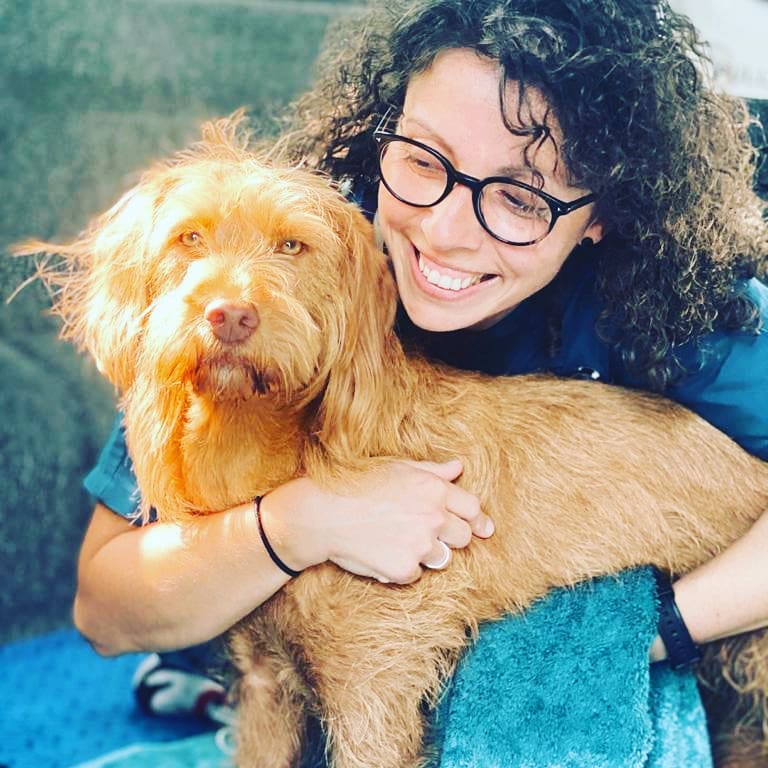About Us
more than 10 years with your lovely pets
Silvia trained as a veterinary nurse in Italy and moved to the UK in 2014 working as neurology nurse at a 24h Hospital. Working closely with the orthopaedic, neurology surgeons and acupuncturist who were offering post-operative physiotherapy and osteoarthritis management, she discovered her passion for physiotherapy. Over the next few years, she gained her Diploma in Animal Physiotherapy and a Level 3 Certificate in Hydrotherapy. She continued working with clients suffering from osteoarthritis and helping to rehabilitate animals suffering from neurological conditions.
In 2018 she created London Vet Rehab and invented the first Mobile Hydrotherapy unit to work around London and help disabled and elderlies providing physiotherapy, hydrotherapy and nutritional advises.

Our Services
-
Physioteraphy
Physiotherapy is a useful technique in treating chronic condition such as osteoarthritis (OA) or as a supportive treatment before and after surgeries such as cruciate repair, patella fixation, hip replacement or more severe cases of fracture repair and spinal surgery. Physiotherapy treatment as part of a multidisciplinary team (MDT) in animal patients is of benefit in physical rehabilitation.
-
Hydroteraphy
We take care of your pet with our Mobile Underwater Treadmill The natural properties of the water such as buoyancy and hydrostatic pressure, create a suitable environment for performing non concussive active exercise which helps to relieve pain, reduce swelling and stiffness, improve blood circulation, improve limb mobility, muscle strength and range of motion. Warm water increases the circulation of blood to the muscles, increasing the supply of oxygen and nutrients, leading to muscle relaxation and reducing pain and stiffness. Improved circulation reduces swelling around an injured area and enhances healing. The buoyancy effect of water reduces the load on weight bearing joints which helps to reduce pain and allows easier movement and exercise. When muscle wastage occurs because of the reduced mobility caused by chronic pain and stiffness, hydrotherapy can help to improve the mobility through safe exercise. Movement in water is more difficult due to the resistance of the water but encouraging pain free limb movement against the resistance of water, muscle mass will increase and thus muscle wastage will be reversed. Cats' aversion to water is widely accepted as fact, but not all cats feel the same about getting wet. So hydrotherapy should be considered as part of the rehabilitation program also for cats.
-
Nutrition Advices
“Let food be thy medicine and medicine be thy food” Hippocrates Nutrition is a functional aspect of health and the connection between diet and health is must to be considered vital for our pets. For this reason is important to respect the anatomy and the physiology every animal patient has evolved with. Cats, as an example, are the worst fed domesticated animals as they should be considered, according to their anatomy and physiology, true or obligate carnivorous. They presents enlarged canine teeth for grabbing and holding prey, specialized carnassial teeth for sharing meat, nocturnal vision, independent ears moving, long whiskers and sharp, retractable claws allowing them to grab and hold prey down. According to this anatomical characteristics cats need an animals-based, high protein diet in order to maintain a proper health. Compared to omnivores and herbivores, carnivores have short, highly acidic digestive tracts, meaning a decreased time that raw meat is in the gut avoiding putrefaction of meat products due to bacterial contamination. Cats do not possess certain digestive enzymes in adequate amounts. For example, amylase in the saliva of humans and is used to break down starches in the mouth. Feline saliva does not contain enzymes and is only used as a lubricant for swallowing large pieces of food. One should conclude that there was no need for felines to develop the ability to produce salivary amylase due to lack of dietary starch. But, have a look to the cat commercial or “medicated” food label, and read the ingredient, you will find a lot of starch and maize ...maize? I thought maize be part of a chicken diet.
-
Senior Car
Geriatric patients can represent major challenges to the owner as well as the veterinarian. Within the past decade, the improved knowledge base, newer technologies, and additional therapeutic options have allowed today’s veterinarians to meet the medical and behavioural challenges of age-related disease better. Whether you call these patients geriatric or "mature," special considerations are required in evaluating, examining, hospitalizing, and generally caring for older pets. However, owners and veterinarians must understand that old age is not a disease, it is a stage of life. The objectives of a managed program of pet geriatric health care include recognizing and controlling health risk factors, detecting preclinical disease, correcting or delaying the progression of existing disorders, and improving or restoring residual function. At present, most progressive practitioners recognize that yearly revaccination recommendations are not based on good science. We must be selective about which vaccines are really necessary for each particular patient. Just because a vaccine is available does not mean that it should be used in every patient, regardless of age, health status, and environment. Older animals (like older humans) tend to get less exercise. This is particularly true of cats, which generally have a more sedentary lifestyle than dogs have. Diminished exercise reduces muscle tone and bone and joint strength increasing the risk of musculoskeletal disease and a tendency toward obesity. Musculoskeletal disease (degenerative joint disease or osteoarthritis) can have different grade of severity in animals; however, it is surprising how often degenerative joint disease is discovered as an incidental finding on x-ray evaluation made to study something else. Sometimes, degenerative joint disease may be a cause of the animal's "slowing down with age." In these cases, herbal treatments integrated with conventional drugs or passive movement of the joint combined with a muscle massage may markedly improve the mobility and general well being. Geriatric animals also have a decreased thirst response. This could lead to dehydration that can obviously compromise already marginally functioning body organs and compound deficiencies in renal function. So it could be very important to prefer a wet diet rather then dry food.
-
Dog
The benefits of physical rehabilitation for dogs have been well documented in canine practice by a lot of professionals and researches. As part of the physical techniques, physiotherapy is performed to increase joint mobilization and relief of muscular Trigger Points (TP); acupuncture might be effective to manage the tension in the muscular fascia and relieve pain while hydrotherapy acts to strengthen the muscle, increasing muscle mass and reducing the muscle tension. In any case, the physical rehabilitation program is designed to meet individual patient needs and evidence highlights the advantages of a multidisciplinary team (MDT) working together in order to provide high-quality patient care.
-
Cat
Our multidisciplinary team approach, that involves various professionals performing different treatment such as physiotherapy, acupuncture and hydrotherapy, could be more effective for the management of cats' conditions compared to the single modalities alone. Working with an integrated approach it is possible to achieve different goals in a shorter time. Few probably know about the fact than also cats suffer from osteoarthritis (OA). It is far less applied and documented in feline practice and as such the benefits found in treating cats are often missed and under-utilised. Rehabilitation in cats should be considered for both post-op, post-trauma and chronic conditions. Studies has shown physiotherapy, as part of a rehabilitation program, being a successful modality in the treatment of feline cases of OA. While physiotherapy works on joint mobilization and the relief of muscular Trigger Points (TP), acupuncture could be effective to manage the tension in the muscular fascia and relieve pain while hydrotherapy acts to strengthen the muscle, increasing muscle mass and reducing the muscle tension. Physical rehabilitation in cats can be more challenging for the practitioner than the application in dogs. Techniques for applying treatment have to be considered in terms of patient comfort, compliance, adaptability, deliverance and success. It is often harder to predict or read feline behaviour and handling skills can be more complex and demanding. However, successfully applied physical therapies can be just as beneficial for any feline patient as it is for their canine counterparts. Primarily it is important to understand feline behaviour. Interpreting body postures and facial changes in order to understand how cats deal with stress and conflicts is important and the delivery of successful physiotherapy depends very much on patient co-operation and relaxation. Every cat is different and unique, requiring all the attention on the single case, focusing the treatments to care for the individual patient’s needs, with the aim of minimising the impact of the disease.
